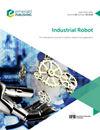A nonlinear robot joint friction compensation method including stick and sliding characteristics
IF 2.5
4区 计算机科学
Q3 ENGINEERING, INDUSTRIAL
Industrial Robot-The International Journal of Robotics Research and Application
Pub Date : 2023-06-06
DOI:10.1108/ir-12-2022-0322
引用次数: 0
Abstract
Purpose Due to dynamic model is the basis of realizing various robot control functions, and it determines the robot control performance to a large extent, this paper aims to improve the accuracy of dynamic model for n-Degree of Freedom (DOF) serial robot. Design/methodology/approach This paper exploits a combination of the link dynamical system and the friction model to create robot dynamic behaviors. A practical approach to identify the nonlinear joint friction parameters including the slip properties in sliding phase and the stick characteristics in presliding phase is presented. Afterward, an adaptive variable-step moving average method is proposed to effectively reduce the noise impact on the collected data. Furthermore, a radial basis function neural network-based friction estimator for varying loads is trained to compensate the nonlinear effects of load on friction during robot joint moving. Findings Experiment validations are carried out on all the joints of a 6-DOF industrial robot. The experimental results of joint torque estimation demonstrate that the proposed strategy significantly improves the accuracy of the robot dynamic model, and the prediction effect of the proposed method is better than that of existing methods. Originality/value The proposed method extends the robot dynamic model with friction compensation, which includes the nonlinear effects of joint stick motion, joint sliding motion and load attached to the end-effector.一种包含粘滞和滑动特性的非线性机器人关节摩擦补偿方法
由于动态模型是实现机器人各种控制功能的基础,在很大程度上决定着机器人的控制性能,因此本文旨在提高n自由度(DOF)串联机器人动态模型的精度。设计/方法/方法本文将连杆动力系统与摩擦模型相结合来创建机器人的动力学行为。提出了一种实用的方法来识别关节的非线性摩擦参数,包括滑动阶段的滑移特性和预滑动阶段的粘滞特性。然后,提出了一种自适应变步长移动平均方法,有效地降低了噪声对采集数据的影响。此外,训练了一种基于径向基函数神经网络的变载荷摩擦估计器,以补偿机器人关节运动过程中载荷对摩擦的非线性影响。对六自由度工业机器人的所有关节进行了实验验证。关节力矩估计的实验结果表明,该策略显著提高了机器人动力学模型的精度,预测效果优于现有方法。该方法对机器人动力学模型进行了扩展,并引入了摩擦补偿,该模型包含了关节粘连运动、关节滑动运动和末端执行器负载的非线性效应。
本文章由计算机程序翻译,如有差异,请以英文原文为准。
求助全文
约1分钟内获得全文
求助全文
来源期刊
CiteScore
4.50
自引率
16.70%
发文量
86
审稿时长
5.7 months
期刊介绍:
Industrial Robot publishes peer reviewed research articles, technology reviews and specially commissioned case studies. Each issue includes high quality content covering all aspects of robotic technology, and reflecting the most interesting and strategically important research and development activities from around the world.
The journal’s policy of not publishing work that has only been tested in simulation means that only the very best and most practical research articles are included. This ensures that the material that is published has real relevance and value for commercial manufacturing and research organizations. Industrial Robot''s coverage includes, but is not restricted to:
Automatic assembly
Flexible manufacturing
Programming optimisation
Simulation and offline programming
Service robots
Autonomous robots
Swarm intelligence
Humanoid robots
Prosthetics and exoskeletons
Machine intelligence
Military robots
Underwater and aerial robots
Cooperative robots
Flexible grippers and tactile sensing
Robot vision
Teleoperation
Mobile robots
Search and rescue robots
Robot welding
Collision avoidance
Robotic machining
Surgical robots
Call for Papers 2020
AI for Autonomous Unmanned Systems
Agricultural Robot
Brain-Computer Interfaces for Human-Robot Interaction
Cooperative Robots
Robots for Environmental Monitoring
Rehabilitation Robots
Wearable Robotics/Exoskeletons.

 求助内容:
求助内容: 应助结果提醒方式:
应助结果提醒方式:


